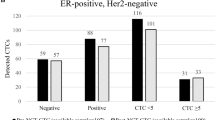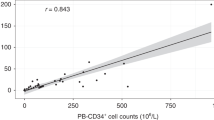Summary:
The presence of cancer cells in autografts of breast cancer patients has been described to have prognostic value or directly lead to relapse. Previously, we demonstrated that apheresis products (APs) collected after induction chemotherapy have a significantly lower likelihood of tumor cell contamination. Here, we examine the prognostic value of micrometastases in autografts. Data from 83 patients with breast cancer treated with autologous blood stem cell transplantation were analyzed. Pan-cytokeratin-FITC conjugated antibodies were used to detect contaminating breast cancer cells in the APs. Progression and survival data analyzed on the basis of three or fewer cancer cells showed no significant differences in outcomes. Of the 83 patients, 11 had more than three cancer cells detectable in their APs. In total, 72 patients were shown to have less than three cells detectable. When patients with more than three cells were compared to patients with 0–3, we found statistically significant differences in progression-free survival. We also found a significant difference in overall survival (OS) between the two groups. No difference was observed in OS since the time of diagnosis. We conclude that patients with more than three contaminating cells in their APs have micrometastases and represent a poor prognosis group.
This is a preview of subscription content, access via your institution
Access options
Subscribe to this journal
Receive 12 print issues and online access
$259.00 per year
only $21.58 per issue
Buy this article
- Purchase on Springer Link
- Instant access to full article PDF
Prices may be subject to local taxes which are calculated during checkout



Similar content being viewed by others
References
Moss TJ, Ross AA . The risk of tumor cell contamination in peripheral blood stem cell collections. J Hematother 1992; 1: 225–232.
Ross AA, Cooper BW, Lazaarus HM, Moss TJ, Ciobanu N . Immunocytochemical detection of tumor cells in bone marrow and peripheral blood stem cell collections from breast cancer patients. Exp Hematol 1995; 23: 1478–1483.
Simpson SJ et al. Detection of tumor cells in the bone marrow, peripheral blood, and apheresis products of breast cancer patients using flow cytometry. Exp Hematol 1995; 23: 1062–1068.
Rill DR, Santana VM, Roberts WM . Direct demonstration that autologous bone marrow transplantation for solid tumours can return a multiplicity for tumorigenic cells. Blood 1994; 84: 380–383.
Fields KK, Elfenbein GF, Trudeau WL . Clinical significance of bone marrow metastases as detected using the polymerase chain reaction in patients with breast cancer undergoing high-dose chemotherapy and autologous bone marrow transplantation. J Clin Oncol 1996; 14: 1868–1876.
Gribben JG, Neuberg D, Freedman AS . Detection by polymerase chain reaction of residual cells with the bcl-2 translocation is associated with increased risk of relapse after autologous bone marrow transplantation for B-cell lymphoma. Blood 1993; 81: 3449–3457.
Braun S, Pantel K, Muller P . Cytokeratin-positive cells in the bone marrow and survival of patients with stage I, II, or III breast cancer. N Engl J Med 2000; 342: 525–533.
Kasimir-Bauer S, Mayer S, Bojko P . Survival of tumor cells in stem cell preparations and bone marrow of patients with high-risk or metastatic breast cancer after receiving dose-intensive or high-dose chemotherapy. Clin Cancer Res 2001; 7: 1582–1590.
Ross AA, Cooper BW, Lazarus HM . Detection and viability of tumor cells in peripheral blood stem cell collections from breast cancer patients using immunocytochemical and clonogenic assay techniques. Blood 1993; 82: 2605–2610.
Vredenburgh JJ, Peters WP, Rosner G . Detection of tumor cells in the bone marrow of stage IV breast cancer patients receiving high-dose chemotherapy: the role of induction chemotherapy. Bone Marrow Transplant 1995; 16: 815–821.
Kessinger A, Armitage J, Bierman P . Clinical outcome of peripheral blood stem cell support. Med Oncol 1994; 11: 43–46.
Kruger W, Togel F, Kroger N . Tumour cell detection in G-CSF mobilised stem cell harvests of patients with breast cancer. Med Oncol 1999; 16: 17–22.
Vannucchi AM, Bosi A, Glinz S . Evaluation of breast tumour cell contamination in the bone marrow and leukapheresis collections by RT-PCR for cytokeratin 19 mRNA. Br J Haematol 1998; 103: 610–617.
Gluck S, Crump M . A Randomised trial of high-dose chemotherapy and autologous stem cell therapy versus standard therapy in women with metastatic breast cancer who have responded to anthracycline or taxane-based induction chemotherapy. National Cancer Institute of Canada Clinical Trials Group, NCIC CTG Protocol Number MA.16, 1997.
Stewart DA, Guo D, Morris D . Superior autologous blood stem cell mobilization from dose-intensive cyclophosphamide, etoposide, cisplatin plus G-CSF than from less intensive chemotherapy regimens. Bone Marrow Transplant 1999; 23: 111–117.
Gluck S, Nabholtz JM, Fargeot P . High-dose chemotherapy with stem cell support in metastatic breast cancer. Oral Presentation at 16th San Antonio Breast Cancer Symposium. 1993.
Ho AD, Germond C, Sinoff C, Gluck S . Mobilization of peripheral stem cells for autologous transplantation by induction chemotherapy combined with GM-CSF in patients with metastatic breast cancer. Proc ASCO 1992; 11: 140.
Kessinger A, Armitage JO . The use of peripheral stem cell support of high-dose chemotherapy. Important Adv Oncol 1993; 167–175.
Peters WP, Ross M, Bredenburg JJ, Meisenberg B, Marks LB . High-dose chemotherapy and autologous bone marrow support as consolidation after standard-dose adjuvant therapy for high-risk primary breast cancer. J Clin Oncol 1993; 11: 1132–1143.
Schwartzberg L, Birch R, Blanco R, Wittlin F, Muscato J . Rapid and sustained haematopoietic reconstitution by peripheral blood stem cell infusion alone following high-dose chemotherapy. Bone Marrow Transplant 1993; 11: 369–374.
Treleaven JG, Mehta J . Bone marrow and peripheral blood stem cell harvesting. J Hematother 1992; 1: 215–223.
Stadtmauer EA, O'Neill A, Goldstein LJ . Conventional-dose chemotherapy compared with high-dose chemotherapy plus autologous hematopoietic stem-cell transplantation for metastatic breast cancer. Philadelphia Bone Marrow Transplant Group. N Engl J Med 2000; 342: 1069–1076.
Crump M, Pritchard K . High dose therapy with stem cell support for breast cancer: the jury is still out. Cancer Treat Res 2000; 103: 115–136.
Gluck S . The worldwide perspective in the adjuvant treatment of primary lymph node positive breast cancer. Breast Cancer 2001; 8: 321–328.
Gluck S, Des Rochers C, Cano C . High-dose chemotherapy followed by autologous blood cell transplantation: a safe and effective outpatient approach. Bone Marrow Transplant 1997; 6: 431–435.
Kruger W, Kroger N, Togel F . Influence of preharvest tumor cell contamination in bone marrow or blood does not predict resultant tumor cell contamination of granulocyte colony-stimulating factor mobilized stem cells. J Hematother Stem Cell Res 2001; 10: 303–307.
Davies FE, Rawstron AC, Pratt G . Positive and negative selection to reduce tumour contamination in peripheral blood stem cell harvests. Hematol Oncol 2000; 18: 111–120.
Franklin WA, Glaspy J, Pflaumer SM . Incidence of tumor-cell contamination in leukapheresis product of breast cancer patients mobilized with stem cell factor and granulocyte colony-stimulating factor (G-CSF) or with G-CSF alone. Blood 1999; 94: 340–347.
Fetsch PA, Cowan KH, Weng DE . Detection of circulating tumor cells and micrometastases in stage II, III, and IV breast cancer patients utilizing cytology and immunocytochemistry. Diagn Cytopathol 2000; 22: 323–328.
Acknowledgements
We acknowledge Jan McLaughlin for help with data acquisition.
Author information
Authors and Affiliations
Rights and permissions
About this article
Cite this article
Syme, R., Stewart, D., Rodriguez-Galvez, M. et al. Micrometastases in apheresis products predict shorter progression-free and overall survival in patients with breast cancer undergoing high-dose chemotherapy (HDCT) and autologous blood stem cell transplantation (ABSCT). Bone Marrow Transplant 32, 307–311 (2003). https://doi.org/10.1038/sj.bmt.1704133
Received:
Accepted:
Published:
Issue Date:
DOI: https://doi.org/10.1038/sj.bmt.1704133
Keywords
This article is cited by
-
Minimal detectable disease confirmed by flow cytometry and poor outcome after autologous stem cell transplantation in peripheral T-Cell lymphomas
Bone Marrow Transplantation (2016)
-
Incidence and prognostic value of tumour cells detected by RT–PCR in peripheral blood stem cell collections from patients with Ewing tumour
British Journal of Cancer (2006)
-
Biological purging of breast cancer cell lines using a replication-competent oncolytic virus in human stem cell autografts
Bone Marrow Transplantation (2005)



